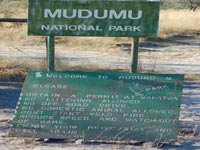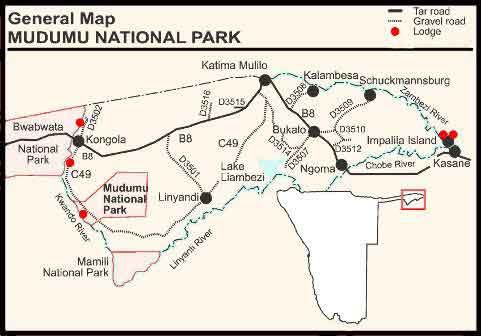|
Mudumu National Park
Nature Reserve of Namibia
|
|
|
|
Mudumu National Park

Mudumu National Park
|
|
I. Map of Mudumu National Park in Caprivi Strip
 Map to Mudumu National park
Map to Mudumu National park
II. Description of Mudumu National Park
Mudumu Nature Reserve is open to visitors although there is no infrastructure provided for tourists (except Lianshulu lodge , located on a concession in the heart of the park).
its 75 000 hectares of land, protected since 1990, are mainly covered with mopane, Terminalia, ACASIA Teks of Rhodesia and fens.
Exeptionnelle wildlife that inhabits the river Kwando (which becomes the Linyanti river where branches off North-east, the south end of the Caprivi Strip, Chobe then becomes the east of Lake Liambezi) .
and wetlands are protected by the status of the park, although each year (beginning of August) of bush fires devastate much of the mountain bikers Mudumu.
We can then observe herds of elephants through the dozens of charred and desolate spaces.
III. Formalities of Mudumu National Park
Travellers wishing to visit the park by their own means must report to the office of Nakatwa.
Lianshulu the lodge is located in the park, "game drives" are organized guided every morning for guests of the lodge. Admission : $ 40 N + 10 N $ for the car.
Booking : At the Katima Mulilo IRDNC or NACOBTA .
IV. Access to Mudumu Park in Caprivi
Mudumu the National Park can be reached by B8, in taking the D3511 after the Kongola.
Permits are obtained at Katima Mulilo .
V. Accommodation in Mudumu Park
You can pitch a tent on a completely blank space on the banks of the river, pree Bureau Conservation Park Mudumu.
Lodgings near Maudumu park :
» Kongola Hotel & Lodge
» Kongola Campsite
V. Flora of Mudumu Park
Mopane :
Dominant species in the woodlands of Southern Africa (from Namibia to Zambia), so much so that one speaks of the Mopane Veld (or Mopane Bushveld) to describe this plant community, the mopane tree is a tree whose size may vary from one bush to over 15 m in height. The leaves of characteristic shape ("butterfly wings"), consist of two sickle-shaped leaflets joined at the base, these leaves are very rich in proteins, constitute one of the favorite food of elephants. They graze on the leaves, turning them into mopane scrub growth with new leaves grow back before those of their counterparts in more developed, constituting the remainder of the dry season food impala, kudu, eland and other herbivores. The flowers are greenish-yellow, in small clusters. The mopane wood, rot and dense as iron, do not float on water and is resistant to termites and provides an excellent fuel. In the rainy season, these trees shed large quantities of large larvae of Lepidoptera (Gonimbrasia belina) which, toast, a dish is very popular with the natives.
Terminalia :
Tropical tree (Combretaceae) such as almond tree, edible fruit, which provide various kinds of wood useful or fruit tannin (myrobalans).
Acasia :
Tree or shrub (Mimosaceae), often thorny, with leaves usually persistent. (600 species of subtropical and warm temperate.) Acacias, very diverse, have small flowers with protruding stamens, the fruit is a pod. Leaves, very small species in drylands are often composed imparipinnate. The flowering branches of 4 species of the temperate zones are sold under the misnomer of mimosa. Acacia catechu provides catechu, A. arabica and A. senegal, gum arabic.
Source : 2008
|



